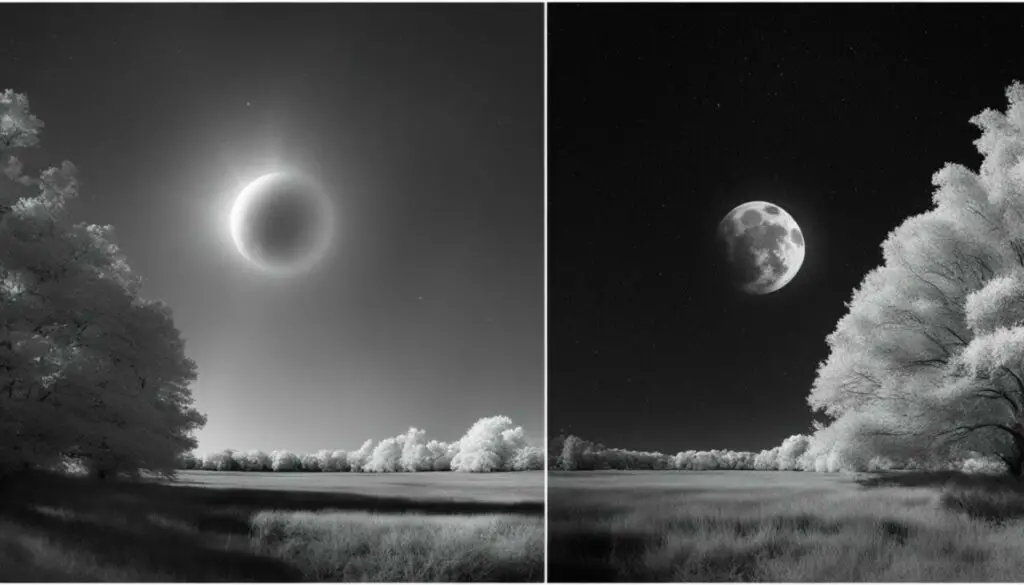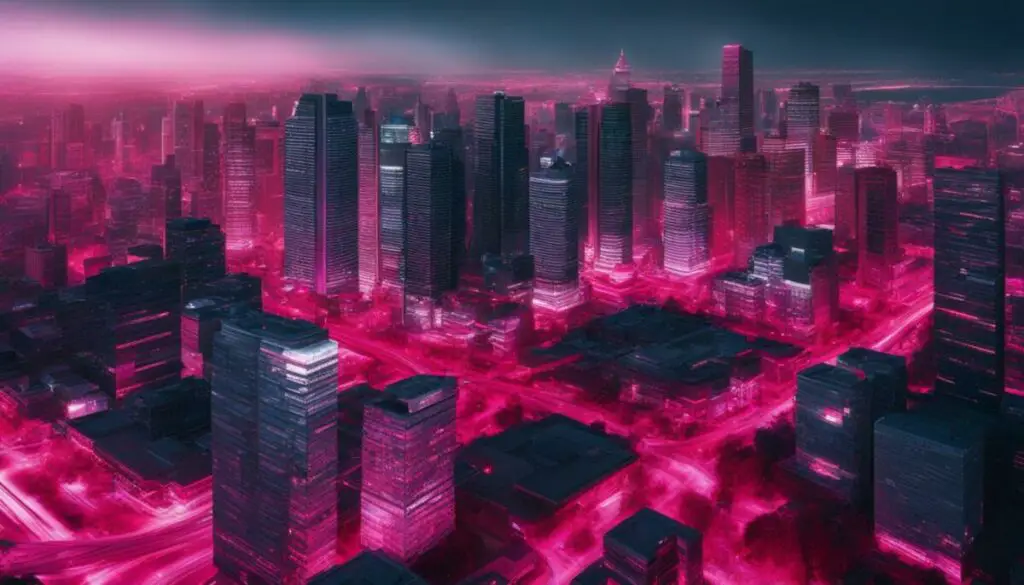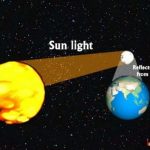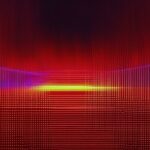Last Updated on 6 months by Francis
A picture taken in visible light and one in infrared can provide fascinating insights into the world around us. While visible light photography captures the colors and details as perceived by the human eye, infrared photography reveals temperature variations and hidden details that are not easily visible to us.
Take, for example, NASA’s 2001 Mars Odyssey orbiter, equipped with the Thermal Emission Imaging System (THEMIS), which captured two views of Phobos, a Martian moon, in both visible light and infrared. The visible light image shows us how the moon appears to our eyes, while the infrared image helps us uncover temperature variations on its surface.
Contents
Key Takeaways:
- Visible light photography captures colors and details as perceived by the human eye.
- Infrared photography reveals temperature variations and hidden details.
- NASA’s Mars Odyssey orbiter captured images of Phobos in both visible light and infrared, showing us different aspects of the moon.
- Infrared imaging helps us uncover details that are not easily visible to the human eye.
- Comparing pictures taken in visible light and infrared can provide a deeper understanding of the world around us.
The Electromagnetic Spectrum and Light Detection
The electromagnetic spectrum encompasses a wide range of light, with visible light being just a small portion of this spectrum. Telescopes, such as NASA’s James Webb Space Telescope, are specially designed to detect light outside the visible range, allowing us to explore hidden regions of space. Infrared light, which has longer wavelengths than visible light, can reveal new details in images and provide valuable information about celestial objects.
By detecting infrared light, telescopes like Webb can observe objects that emit less energy or visible brightness, such as cool bodies and dense nebulae. This enables astronomers to study objects that would otherwise be difficult to observe using visible light photography alone. Infrared light can penetrate through dust particles more easily than visible light, allowing telescopes to see objects inside dense nebulae or protoplanetary clouds.
Adding a table below to showcase the different regions of the electromagnetic spectrum:
| Region | Wavelength Range | Major Applications |
|---|---|---|
| Radio Waves | Longer than 1mm | Radio communications, radar |
| Microwaves | 1mm – 1m | Microwave ovens, satellite communications |
| Infrared | 700nm – 1mm | Thermal imaging, remote controls |
| Visible Light | 400nm – 700nm | Human vision, photography |
| Ultraviolet | 10nm – 400nm | Sunscreen, forensic investigations |
| X-Rays | 0.01nm – 10nm | Medical imaging, airport security |
| Gamma Rays | Shorter than 0.01nm | Nuclear medicine, cancer treatment |
As seen in the table above, visible light falls within a narrow wavelength range of 400nm to 700nm, sitting between the ultraviolet and infrared regions of the electromagnetic spectrum.
Advantages of Infrared Imaging
Infrared imaging offers several advantages in the field of astronomy. Firstly, some objects are better observed in infrared wavelengths, as they emit less energy or visible brightness. This allows astronomers to study cooler objects that may not be easily visible in visible light. Infrared light can also penetrate through dust particles more easily than visible light, enabling telescopes to see objects inside dense nebulae or protoplanetary clouds. This ability to see through dust opens up new avenues for studying low-energy brown dwarfs and young protostars forming within these dusty environments.
In addition, infrared light provides insights into the early universe. As light travels through space, it can become redshifted due to the expansion of the universe. Infrared light is particularly effective at detecting this redshifted light, allowing astronomers to study distant objects and understand the evolution of the universe over time. By capturing images in infrared, astronomers can delve deeper into the mysteries of the cosmos and gain a better understanding of its origins and development.
To emphasize the advantages of infrared imaging, consider the following table:
| Advantages of Infrared Imaging |
|---|
| Ability to observe cooler objects |
| Penetration through dust particles |
| Detection of low-energy brown dwarfs |
| Study of young protostars |
| Insights into the early universe |
Image source: https://seowriting.ai/32_6.png
Limitations of Visible Light Photography
While visible light photography has been widely used and has its advantages, it also comes with certain limitations that can hinder the capture of clear and detailed images in certain scenarios. Understanding these limitations is crucial for photographers and researchers to make informed decisions about when to utilize visible light photography and when to explore alternative methods such as infrared imaging.
One of the main challenges in visible light photography is the susceptibility of visible light to bounce off dust particles present in the atmosphere. This can lead to difficulties in capturing clear images, especially in environments with dense nebulae or gas and dust clouds. The particles can create halos around stars and result in blurry images, compromising the sharpness and quality of the captured photographs.
Another limitation of visible light photography is the narrow range of the spectrum that is visible to the human eye. Our eyes can only perceive a limited portion of the electromagnetic spectrum, restricting our ability to detect and study certain celestial objects that emit light outside this range. This limitation can be overcome by utilizing infrared imaging techniques, which allow us to observe objects that emit infrared radiation and capture details that are not easily visible in visible light.
The Limitations of Visible Light Photography:
| Limitations | Impact |
|---|---|
| Susceptibility to dust particles | Blurry images, halo effects |
| Restricted range of visible spectrum | Limited ability to detect certain objects |
In conclusion, while visible light photography has its advantages and is widely used in various fields, it does have inherent limitations when it comes to capturing clear and detailed images. The susceptibility to dust particles and the limited range of the visible spectrum can restrict the ability to capture certain objects effectively. However, by understanding these limitations and exploring alternative methods such as infrared imaging, researchers and photographers can overcome these challenges and expand their capabilities in capturing and studying celestial objects.
Exploring Hidden Details with Infrared Light

Infrared light, a powerful tool in astronomy, allows us to reveal hidden details and deepen our understanding of celestial objects. By observing in infrared wavelengths, astronomers can study objects that emit infrared radiation, including cool bodies such as planets and certain types of stars. The use of infrared imaging techniques enables us to capture images that reveal a hidden universe of star and planet formation, not easily visible in visible light.
One advantage of infrared imaging is its ability to penetrate dust particles more easily than visible light. This allows astronomers to detect objects within dense nebulae and protoplanetary clouds, providing insights into the formation and evolution of these celestial structures. The infrared light slipping through the dust particles unlocks the ability to study low-energy brown dwarfs and young protostars forming within these dusty environments, offering new perspectives on stellar birth and early evolution.
Through the use of infrared imaging, astronomers can also explore the early universe. Infrared light that has been redshifted due to the expansion of space can be detected, providing valuable clues about the formation of galaxies, the presence of dark matter and energy, and the evolution of black holes. The study of the early universe is crucial for understanding the origins of our cosmic environment and the processes that have shaped it over billions of years.
| Advantages of Infrared Imaging in Astronomy | Examples |
|---|---|
| Reveals hidden details | Uncovering star and planet formation in dense nebulae |
| Penetrates dust particles | Detecting low-energy brown dwarfs and protostars |
| Explores the early universe | Studying redshifted light and galaxy formation |
By harnessing the power of infrared light, astronomers can unlock a wealth of hidden information and gain new insights into the mysteries of the universe. The unique capabilities of infrared imaging allow us to observe celestial objects in ways that were previously impossible, enabling us to expand our knowledge and deepen our understanding of the cosmos.
The Role of Infrared Light in Astronomy

Infrared light plays a crucial role in various aspects of astronomy, contributing to our understanding of the universe and beyond. By observing celestial objects in the infrared spectrum, astronomers can uncover hidden details and explore phenomena that are not easily visible in visible light. Let’s dive into the significance of infrared light in space exploration and studying the early universe.
One of the primary roles of infrared light in astronomy is its ability to detect objects that emit less energy or visible brightness. This allows astronomers to study cool bodies such as planets and brown dwarfs, providing valuable insights into their formation and characteristics. Infrared light also enables the observation of objects within dense nebulae and gas clouds, revealing details that would be obscured in visible light. Furthermore, the detection of redshifted infrared light helps astronomers explore the early universe, shedding light on phenomena like dark matter and energy, black holes, and the evolution of galaxies over time.
| Infrared Light in Astronomy | Advantages |
|---|---|
| Observing cool bodies | Insights into planet and brown dwarf formation |
| Exploring dense nebulae and gas clouds | Revealing obscured details |
| Studying the early universe | Understanding dark matter, black holes, and galaxy evolution |
“Infrared light allows astronomers to see the invisible and explore the mysteries of the universe that are hidden from the human eye.”
The role of infrared light in astronomy extends beyond these advantages. It provides a unique perspective that complements visible light observations, enabling a more comprehensive understanding of celestial objects and their environments. The advancements in infrared technology continue to push the boundaries of our knowledge, improving the quality and clarity of infrared images and expanding the applications of infrared imaging in space exploration.
In conclusion, infrared light plays a vital role in astronomy, facilitating the study of objects that emit less visible brightness, exploring dense environments, and uncovering the mysteries of the early universe. This powerful tool allows astronomers to deepen their understanding of the universe and make groundbreaking discoveries. As technology advances, further developments in infrared imaging will continue to enhance our exploration of the cosmos, pushing the boundaries of human knowledge.
Challenges and Considerations in Infrared Imaging
Infrared imaging, while offering numerous advantages in the field of astronomy, comes with its own set of challenges that astronomers must consider. One of the main challenges is the potential for blurry images or star bloat. Factors such as bad focus, bad collimation, different focus lengths for visible and infrared light, bad tracking, and poor atmospheric conditions can contribute to the blurriness of infrared images. To overcome these challenges, astronomers employ various techniques and technologies.
One approach to addressing blurry images is the use of focus motors. These motors allow astronomers to make precise adjustments to the focus of their instruments, ensuring that the captured images are sharp and clear. Additionally, proper instrument calibration is vital for achieving optimal image quality. By calibrating the instruments, astronomers can correct for any inherent optical aberrations or distortions, enhancing the overall clarity of the images.
Despite these efforts, artifacts and hot pixels can still be present in infrared images. Artifacts are unwanted features or inconsistencies that can arise during image capture and processing. Hot pixels, on the other hand, are individual pixels that emit a higher signal or appear brighter than they should, leading to potential inaccuracies. To mitigate the impact of these artifacts and hot pixels, astronomers commonly use techniques such as dark frames and filters. Dark frames help in subtracting unwanted signal from the images, while filters can help enhance image quality by eliminating specific wavelengths of light.
| Challenges | Solutions |
|---|---|
| Blurry images or star bloat | Use of focus motors and proper instrument calibration |
| Artifacts and hot pixels | Employing techniques like dark frames and filters |
“Infrared imaging presents unique challenges for astronomers, but with the right techniques and technologies, we can overcome them and capture clear and detailed images. By utilizing focus motors, calibrating our instruments, and implementing strategies to minimize artifacts and hot pixels, we can enhance the quality of our infrared images and gain valuable insights into the celestial objects we study.”
Considering these challenges and implementing the appropriate solutions is crucial for astronomers to obtain accurate and reliable infrared images. By continuously refining techniques and technologies, we can push the boundaries of infrared imaging and further explore the wonders of the universe.
The Future of Infrared Imaging

Infrared imaging technology is poised for significant advancements in the coming years, paving the way for improved infrared photography and expanding its potential applications. These advancements will revolutionize our ability to study celestial objects and provide invaluable insights into the universe.
One area of focus for future developments is the enhancement of focus motor systems and instrument calibration techniques. These improvements will help sharpen the quality of infrared images, resulting in clearer and more detailed captures. Combined with advancements in detector technology and image processing algorithms, the overall clarity and quality of infrared images will be greatly improved, providing astronomers with a wealth of valuable data.
Another aspect of the future of infrared imaging lies in the expansion of its non-astronomical applications. While infrared technology is already widely used in fields such as medicine, security, and environmental monitoring, ongoing advancements will continue to push the boundaries of its capabilities. Infrared imaging has the potential to revolutionize diagnostics and monitoring in the medical field, enhance security systems by detecting heat signatures, and contribute to environmental studies by monitoring temperature variations in different ecosystems.
As infrared imaging technology continues to evolve, it holds immense promise for the future of scientific exploration and understanding. From unraveling the mysteries of the early universe to advancing fields beyond astronomy, such as medicine and environmental monitoring, the future of infrared imaging looks bright.
Advancements in Infrared Technology: A Glimpse into the Future
The following table highlights some key advancements in infrared technology that we can expect to see in the near future:
| Advancement | Description |
|---|---|
| Improved Focus Motor Systems | Enhanced focus motors will improve the sharpness of infrared images, resulting in clearer and more detailed captures. |
| Enhanced Instrument Calibration Techniques | Advanced calibration techniques will ensure accurate and precise measurements, leading to higher image quality. |
| Advancements in Detector Technology | New detector technologies will increase sensitivity, allowing for the detection of fainter infrared signals and improving overall image quality. |
| Improved Image Processing Algorithms | Enhanced algorithms will enable more efficient and accurate processing of infrared images, resulting in higher-quality final outputs. |
Applications of Infrared Imaging Beyond Astronomy
Infrared imaging has proven to be a valuable technology beyond its applications in astronomy. Its ability to detect thermal radiation and capture images in the infrared spectrum has found practical use in various fields, including medicine, security, and environmental monitoring. Let’s explore some of the non-astronomical uses of infrared technology.
Medicine:
Infrared imaging, also known as thermography, plays a significant role in medical diagnostics. By measuring and visualizing heat patterns emitted by the body, infrared cameras can help identify abnormal temperature variations that may indicate underlying health conditions. This non-invasive technique is particularly useful in detecting vascular abnormalities, monitoring blood flow, and diagnosing conditions such as breast cancer, inflammation, and musculoskeletal disorders.
Security:
Infrared cameras are widely used for security purposes due to their ability to detect and capture thermal signatures. By distinguishing differences in temperature, these cameras can identify potential threats or intruders even in complete darkness. Infrared technology is employed in surveillance systems, border control, and law enforcement to enhance situational awareness and improve safety measures.
Environmental Monitoring:
Infrared imaging is instrumental in studying and monitoring environmental changes. It allows researchers to assess temperature variations in ecosystems, track heat dissipation in urban areas, and monitor energy consumption in buildings. By analyzing infrared images of vegetation, scientists can study plant stress, pest infestation, and even estimate crop yields. This valuable information aids in making informed decisions regarding land use, conservation efforts, and sustainable development.
| Applications | Description |
|---|---|
| Medicine | Thermography, blood flow monitoring, diagnostics |
| Security | Thermal signature detection, surveillance systems |
| Environmental Monitoring | Temperature assessment, vegetation analysis |
In conclusion, infrared imaging extends its utility beyond the realm of astronomy. Its applications in medicine, security, and environmental monitoring showcase the versatility and significance of this technology in various fields. From aiding in medical diagnosis to enhancing security measures and monitoring environmental changes, infrared imaging continues to contribute to advancements and improvements in diverse industries.
Advantages of Visible Light Photography
Visible light photography offers several advantages that make it a preferred choice in various fields. One of the key benefits is that the human eye is naturally sensitive to visible light, allowing us to easily observe and interpret images captured in this spectrum. This familiarity with visible light images provides a relatable view of the world, showcasing colors and details as perceived by our own eyes.
Furthermore, visible light photography is widely used in fields such as art, journalism, and everyday photography. Its ability to accurately represent the visual world, with its vibrant colors and intricate details, makes it a versatile and widely accessible medium for capturing and documenting moments.
In scientific applications, visible light photography plays a crucial role in fields such as biology and medicine. The use of visible light allows researchers and medical professionals to examine and study the intricate structures and processes within living organisms. From capturing the vibrant colors of coral reefs to visualizing microscopic cells, visible light photography provides valuable insights into the natural world.
Applications of Visible Light Photography:
- Artistic expression and documentation
- Journalism and media coverage
- Biology and medical imaging
- Everyday photography and social media
In summary, visible light photography offers the advantages of familiarity, accurate representation of the visual world, and wide usability in various fields. While infrared imaging has its own unique benefits, visible light photography remains an essential and preferred approach for capturing images and understanding the world around us.
| Advantages of Visible Light Photography |
|---|
| Familiarity and relatable view |
| Vibrant colors and intricate details |
| Versatility in different fields |
| Wide usability in art, journalism, and everyday photography |
| Crucial role in biology and medical imaging |
Conclusion
After comparing a picture taken in visible light and one in infrared, it is clear that each spectrum offers unique advantages in the study of celestial objects. Visible light photography, while limited by its susceptibility to dust particles and certain objects, provides a familiar and relatable view of the world. It allows us to see colors and details as perceived by the human eye, making it widely used in various fields, such as art and everyday photography.
On the other hand, infrared imaging proves to be a valuable tool in astronomy. By detecting infrared light, telescopes can observe objects that emit less energy or visible brightness, such as cool bodies and dense nebulae. Infrared light also helps penetrate through dust particles, allowing for the detection of hidden details within these dense environments. Furthermore, the ability to detect redshifted infrared light helps astronomers explore the early universe and understand phenomena like dark matter and energy.
Advancements in infrared imaging technology are expected to further enhance the quality and clarity of captured images. Focus motor systems, instrument calibration techniques, and improvements in detector technology and image processing algorithms will contribute to a better understanding of celestial objects in the infrared spectrum. Moreover, infrared imaging extends beyond the field of astronomy and has applications in medicine, security, and environmental monitoring, showcasing its versatility and significance in various fields.
FAQ
What is the difference between a picture taken in visible light and one in infrared?
A picture taken in visible light shows the appearance of an object as seen by the human eye, while an infrared picture reveals temperature variations on the object’s surface.
What is the advantage of using infrared imaging in astronomy?
Infrared light can penetrate through dust particles more easily than visible light, allowing telescopes to see objects inside dense nebulae or protoplanetary clouds. This enables the study of low-energy brown dwarfs and young protostars forming within these dusty environments.
Can infrared imaging help us understand the early universe?
Yes, by detecting light that has been redshifted due to the expansion of space, infrared light can provide insights into the early universe and phenomena such as dark matter and energy, black holes, and galaxy evolution over time.
What are the limitations of visible light photography?
Visible light photography is prone to bouncing off dust particles, causing difficulties in capturing clear images from dense nebulae or gas and dust clouds. Additionally, the human eye can only perceive a limited range of visible light, restricting our ability to detect and study certain celestial objects.
Infrared light can reveal details that are not easily visible in visible light, allowing astronomers to study cool objects that emit less energy or visible brightness, such as planets and brown dwarfs. It also enables the detection of objects within dense nebulae and protoplanetary clouds.
What role does infrared light play in astronomy?
Infrared light allows the observation of objects that emit less energy or visible brightness, providing valuable insights into the formation and characteristics of cool bodies like planets and brown dwarfs. It also helps in studying objects in dense nebulae and gas clouds, revealing details that would be obscured in visible light.
What are the challenges in infrared imaging?
Blurry images or star bloat can be caused by factors such as bad focus, bad collimation, different focus lengths for visible and infrared light, bad tracking, and poor atmospheric conditions. Artifacts and hot pixels can also be present in infrared images, requiring proper calibration and consideration.
What are the future developments in infrared imaging?
Advances in focus motor systems, instrument calibration techniques, detector technology, and image processing algorithms are expected to enhance the sharpness, quality, and clarity of infrared images. These developments will improve our ability to study and understand celestial objects in the infrared spectrum.
Where else is infrared imaging used beyond astronomy?
Infrared imaging has applications in fields such as medicine, security, and environmental monitoring. It is used in diagnostics, monitoring blood flow, detecting heat signatures for security purposes, and assessing temperature variations in different ecosystems for environmental studies.
What are the advantages of visible light photography?
Visible light photography is easier to observe and interpret since the human eye is naturally sensitive to visible light. It allows us to see colors and details as perceived by the human eye, providing a familiar and relatable view of the world.









